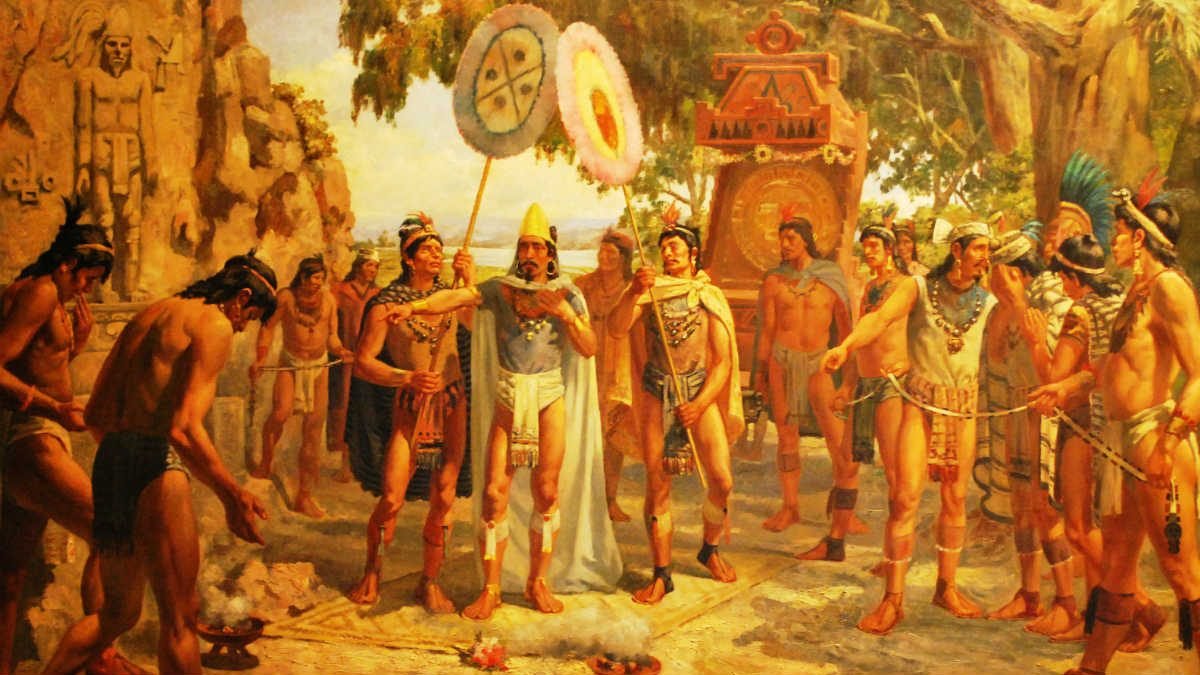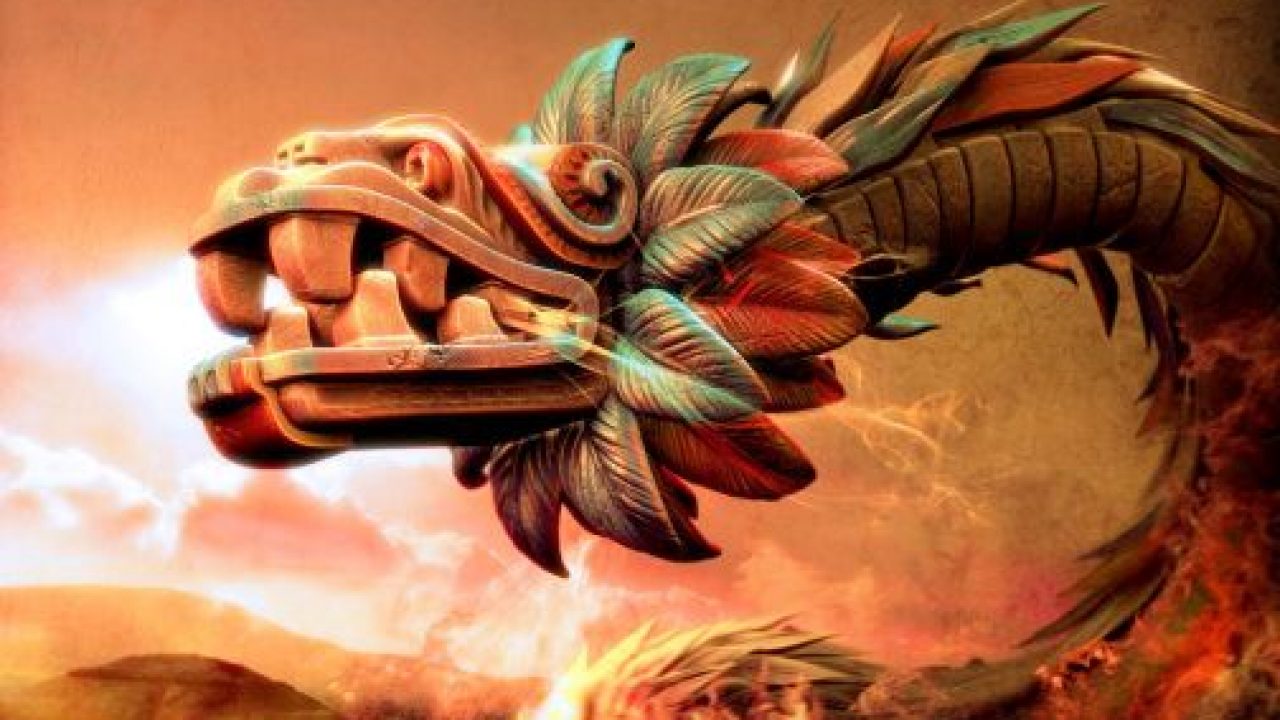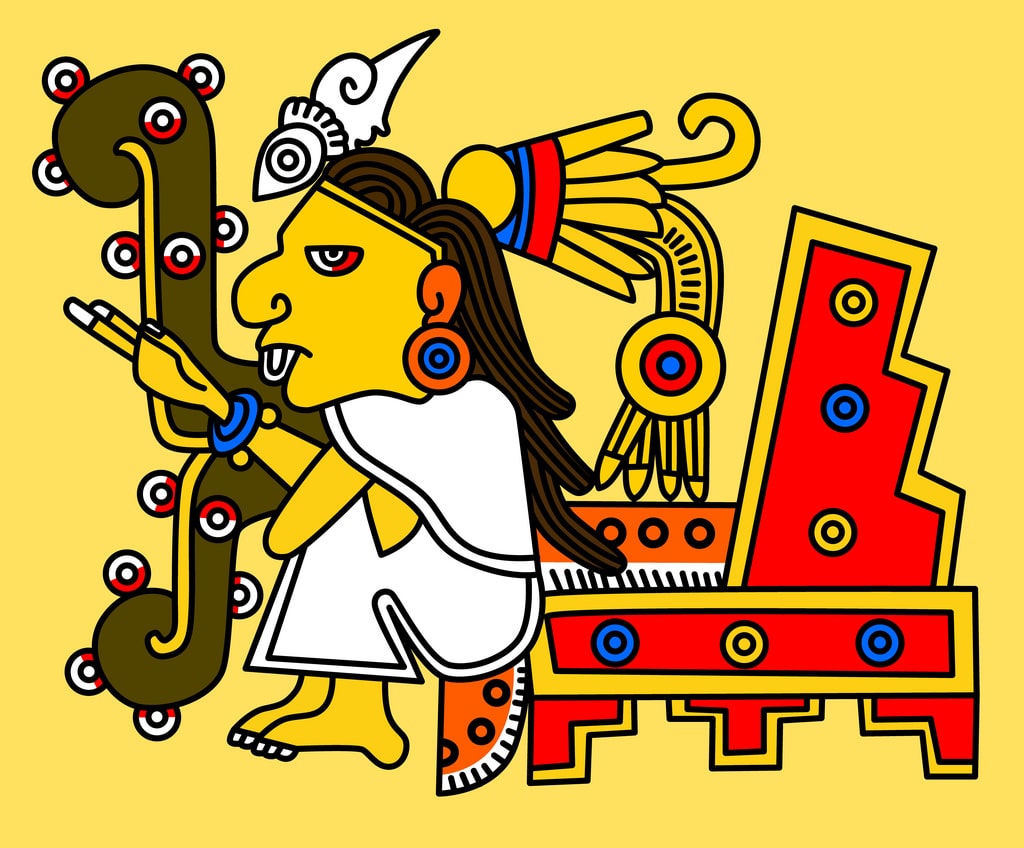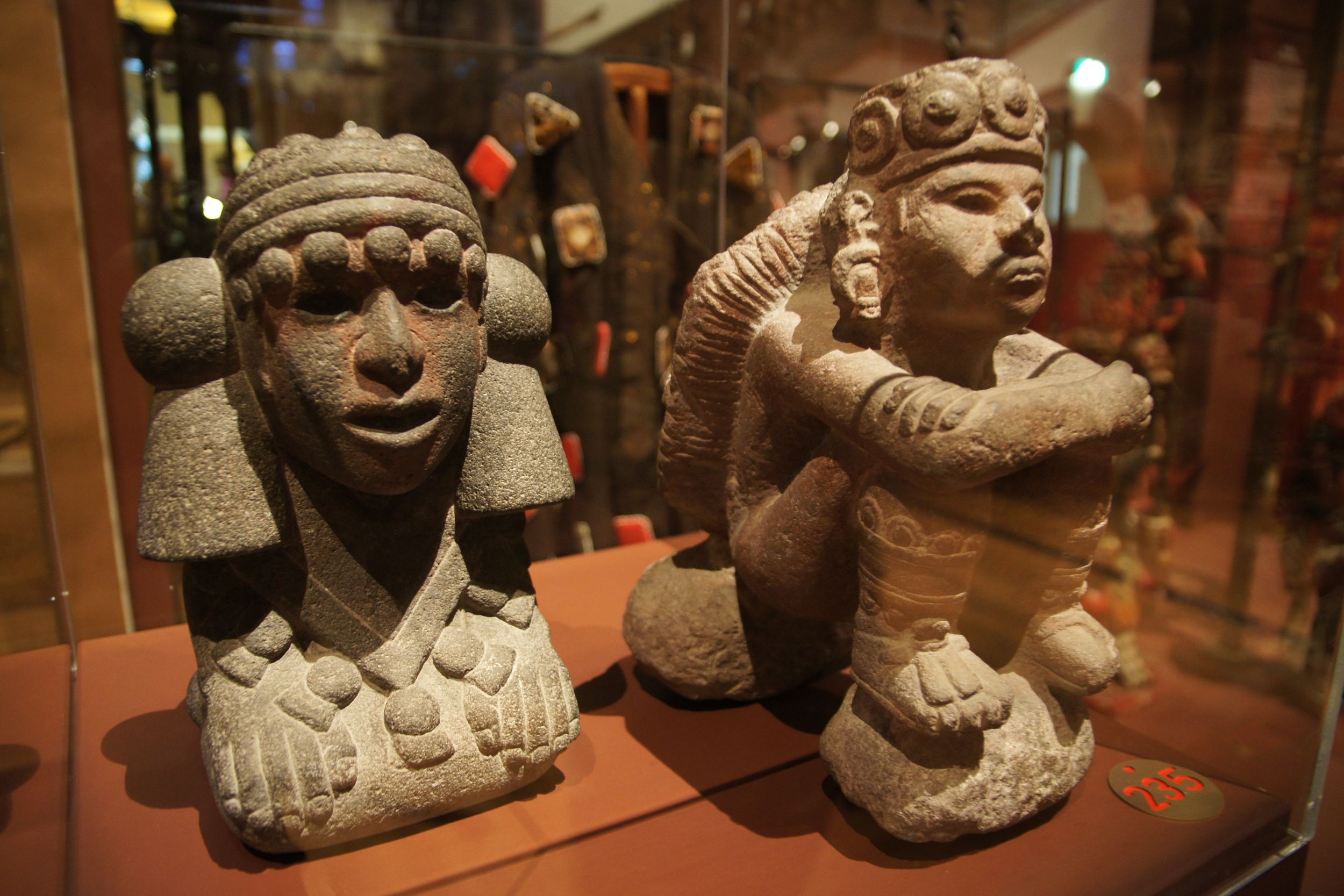Upon the arrival of the Europeans, the peoples who inhabited the center of what is now known as Mexico had a religious tradition that went back thousands of years where the relationship with the gods was essential. Here we will know who they were mexica gods.
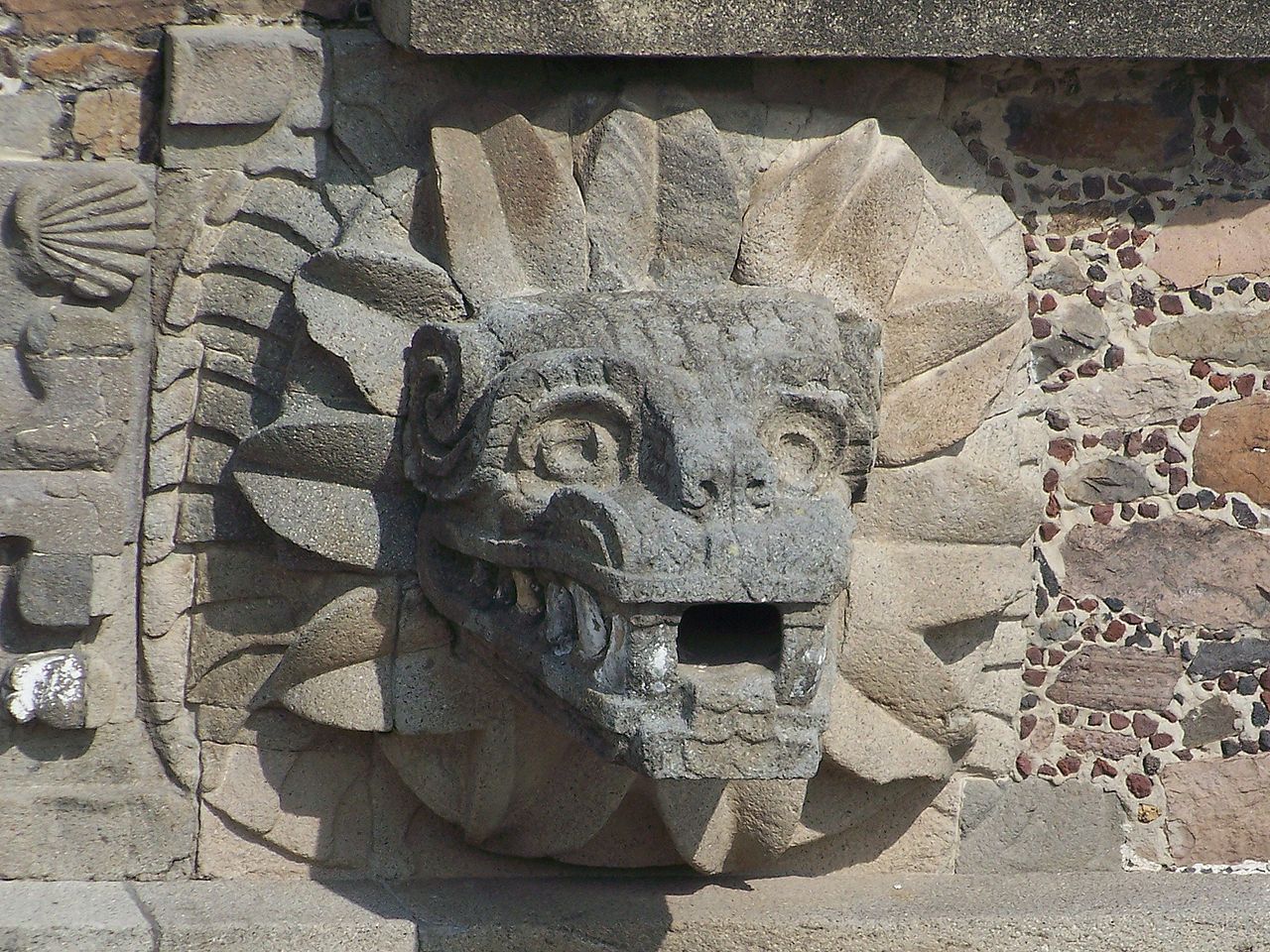
mexica gods
The Mexicas settled in the Valley of Mexico, probably after migrating from the southern region of the current United States and northern Mexico to the central region of the current Mexican territory, where the Mexicas originally settled on an island that was in the lake. from Texcoco. Aztec legends said that these people settled there after seeing an omen from the god Huitzilopochtli indicating where they should live. According to these legends, that omen would be the image of an eagle, perched on a cactus, holding a snake.
Thus, Tenochtitlán was founded in 1325, and became a very prosperous city and capital of the Aztec Empire. The growth of this city was related to the strengthening of the Mexicas and the conquest of neighboring towns. Historians point out that, as the city of Tenochtitlán grew rich, the Mexica allied themselves with other neighboring cities, forming a Triple Alliance that conquered the peoples of the region. In this way, the Aztecs formed an empire that had about eleven million inhabitants.
Vision of the world
To understand the role of the Mexica gods in their religion, we must begin by familiarizing ourselves with how the Mexica perceived the universe. Broadly speaking, the Mexica thought of the earth as a flat, rectangular or round surface, surrounded by a sea that rose on the horizon until it reached the heavens. These were supported by four gods (Tlahuizcalpantecuhtli, Xiuhtecuhtli, Quetzalcoatl and Mictlantecuhtli) each associated with a cardinal point: in turn, East, North, West and South.
In the vertical dimension of the cosmos, the Mexica believed in the existence of thirteen levels of the "superworld" and nine of the underworld. Each of these levels was inhabited by Mexica gods, stars, and other mythological beings. : the Moon lived in the first, Citlalicue (with a skirt of stars) in the second, Tonatiuh, the Sun, in the third, and so on up to thirteen and higher, Omeyocan, (Place of Duality), home of the original couple, Ometecuhtli and Omecíhuatl.
Also of vital importance were the ways in which the Mexica perceived time. There were basically two calendars: a 365-day solar calendar made up of eighteen twenty-day months plus five “unlucky” days; and another ritual of 260 days formed by the combination of signs of twenty days with thirteen numbers. Each month of twenty days was accompanied by important festivities in the main towns of the Mexica empire. The ritual calendar was used to calculate the appropriate days for certain activities (planting, harvesting, hunting, electing a king, etc.)
The first Spanish chroniclers were amazed by the large number of Mexica gods they found (no less than 2.000 according to López de Gómara). Elements like water, air, earth and fire; physical spaces such as hills or rivers; natural phenomena such as lightning or rain; animals, plants, and even certain objects such as musical instruments could be gods or receptacles for divine forces.
Even some individuals, slaves or captives of war, but also priests or leaders "possessed" by a particular deity, could become ixiptla (image or representative in Nahuatl) of the gods in question, either only on that occasion or for the rest of their lives. Similarly, a god like Quetzalcoatl could take the form of an element of nature such as air, as a planet (Venus), appear in the form of an animal (monkey, opossum), a captive slave or a political leader.
Undoubtedly, rituals, both public and private, played a vital role in the life of the ancient Mexica, to the point that each stage of the life cycle (birth, marriage, death, etc.) involved the performance of specific rites. . In the same way, different social groups, communities or states had their own rituals designed to venerate their patron gods or promote their influence in society.
Of course, it was the ritual practice of sacrifice that has attracted the most attention among those who have described the religion of the ancient Mexicans. As in many other world religions, the sacrifice of animals and human beings was a central element in the worldview of the Mexica. Its purpose was to feed the Sun and the Earth. In the myth of the origin of the Sun and the Moon, the story is told of how two gods sacrificed themselves in a giant bonfire to become the two celestial bodies and so that they began to move in the sky.
In fact, the idea that life is born from death was fundamental in Mesoamerican thought, as in the myth of the origin of the human being from the bones. We know that children, young men and women, the elderly, could all be "images" of deities for certain periods of time, at the end of which they would be sacrificed.
Mexica gods and society
Most Mexica gods were broadly tied to specific cities, towns, or neighborhoods. The increasing number of gods in the postclassical era paralleled the constant evolution of society, and the structure of the 'family' of gods reflected the social structure of the community; If we look at the guilds of the time (groups of people who specialized in the same trade) we quickly recognize their associated gods: Coyotl Inahual for the feather workers, Xipe Tótec for the precious metal workers, etc.
Even the less fortunate, those often mistakenly referred to as slaves (tlatlacotin), were protected by a god as powerful as Tezcatlipoca. Obviously, the ruling classes had the privilege of having their own guardian deities, such as Tlaloc (protective priests), Xochipilli (nobles), and Tezcatlipoca with Huitzilopochtli (for the king himself).
The Mexica pantheon of gods was complex and confusing, the gods were assigned different meanings and functions, due to that some of them have multiple names. Furthermore, the Spanish transcription of the Nahuatl language resulted in different spellings. The Mexica gods were represented in animal form, in animal-human form, or as ritual objects. Each god belonged to one of three areas of the world of the gods:
- the creator deities in the overworld of Topan (heaven)
- the fertility gods in the middle world Cemanahuatl (earth)
- the gods of the Mictlan underworld
Quetzalcoatl
Quetzalcóatl (Quetzal Serpent or Bright-Tailed Feathered Serpent; Itzá Kukulcán, Quiché Q'uq'umatz) is a syncretic deity of various Mesoamerican cultures, including the Toltecs, Aztecs, and Mayas. The god Tlahuizcalpantecuhtli is likely to be a special form of Quetzalcoatl. In the first representations, Quetzalcóatl becomes zoomorphic, represented as a large rattlesnake whose body is covered with the feathers of the sacred quetzal bird.
In Aztec mythology, Quetzalcoatl is the god of the wind, the sky, the earth, and a creator god. He symbolizes the ocean. The indigenous peoples of Mesoamerica believed in five eras (five suns) and it is said that the human race of the present time, the fifth sun, was created by Quetzalcoatl from the bones of the previous human races with the help of Cihuacoatl. There are several stories about the origins of Quetzalcóatl: it is said that he was born to the virgin Chimalman, Coatlicue or Xochiquetzal or to one of the four sons of Ometecuhtli and Omecihuatl.
At Teotihuacán he was worshiped as a nature god from the beginning. The main shrine to him was in Cholula. He was considered the ruler of the second world age. Tradition has it that Quetzalcóatl, when embarking and leaving for the mysterious Tlapallan, announced that one day he would cross the Atlantic with his retinue to take possession of his empire again.
This is given as one of the reasons why the ruler Moctezuma II only hesitantly opposed the Spanish conquistadors under Hernán Cortés in the XNUMXth century: he could not rule out involvement with the god's messengers. In recent research, this explanation is known as interpreted historical myth, which was due to the intentions of Spanish justification.
Hernán Cortés did not have permission to conquer what is now Mexico, his mission was only to explore. Since the Conqueror was therefore accused by a Spanish court, he wrote a letter to the emperor, in which he informed that the Aztecs had already passed their empire to him before he came to fight because they had a prediction where Cortés was the ruler. expected. Thus, the conquest of Mexico could be interpreted as the suppression of an Aztec uprising and Cortés escaping certain death penalty for unauthorized conquest.
Huitzilopochtli
Huitzilopochtli (Hummingbird of the south or hummingbird to the left, according to the Mexica imagination, the south was to the left, following the path of the sun from east to west) It is the most important of the Mexica gods, their tribal guardian god. At his command, the Aztecs set out from the mythical land of Aztlán, and then led a nomadic lifestyle for a long time, after which he ordered to settle and found a city of Tenochtitlán. On the way, they took it in the form of a sacred bundle: tlaquimilolli.
According to Aztec beliefs, he was the god of war and the sun at its zenith, the personification of the sky during the day, summer and midday. The myths about the creation of the world appear as the fourth son of the Lord and Lady of the duality Ometecuhtli (Tonacatecuhtli) and Omecihuatl (Tonacacihuatl), who was born without a body, and in this form existed for 600 years. He was considered a brilliant rival of the black Tezcatlipoca (Yayauhqui Tezcatlipoca).
According to other legends, he was born to the goddess Coatlicue. Her pregnancy was caused by a ball of bird feathers, which the goddess hid under her skirt. The brothers of the yet to be born Huitzilopochtli wanted to kill their mother (they considered themselves dishonored by her pregnancy), but Huitzilopochtli was born armed and defeated all opponents, including his sister Coyolxauhqui (golden bells), whose severed head he threw into the sky creating the Moon.
In the official religion of the Aztecs, Huitzilopochtli resembled the powerful god Tezcatlipoca and assumed some of the attributes of the sun god Tonatiuh and Quetzalcoatl. During the coronation, the Mexican rulers became a living incarnation of Huitzilopochtli.
According to Aztec beliefs, Huitzilopochtli was born again every day and died with the setting of the sun. He needed strength as a sun god to make his journey in the sky and defeat the Centzon Huitznaun star deities every day. He had to be "fed" with human blood and human hearts still trembling. Prisoners of war were sacrificed. In order to guarantee a sufficient number of victims, the Aztecs carried out the so-called flower wars with the main objective of capturing prisoners, not conquering or plundering.
Huitzilopochtli was represented with a blue body and yellow stripes on his face, well armed and dressed in hummingbird feathers. In his honor, at the end of the year the festival of Panquetzaliztli (hoisting of the flag) was celebrated, during which ceremonial fights were fought and those who lost were sacrificed to him.
tezcatlipoca
Tezcatlipoca (also Metzli, the Lord of the Smoking Mirror) – In the Aztec pantheon, a deity of evil, darkness, and revenge, whose lineage is not entirely clear. According to mythical accounts, he was the creator god and Sun of the Earth (Nahui Ocelotl) in the era of the first world and one of the four sons of the creator god Ometeotl (Two Gods), the dual creator of the world consisting of the beginning male Ometecuhtli (Lord of Duality) and female Omecihuatl (Lady Duality).
He was the god of providence, fate, darkness, and sin. He created fire, led wizards and warriors. He was represented with a face painted with black stripes, with obsidian or flint knives, with an obsidian mirror (a smoking mirror). He ruled the night and the north side of the world, the symbol of him in Aztec cosmology was the constellation Ursa Major. According to Mexica mythology, his wife was the goddess Xilonen. He kidnapped the goddess Xochiquetzal, the animal that represents Tezcatlipoca is the jaguar.
The smoking mirror allows him to see everything on earth, underground and in the sky, as well as see and predict the future. She was the main deity worshiped in Texcoco. Tezcatlipoca and his twin brother Quetzalcoatl became serpents and defeated the monster Tlalteuctli, and from the two halves of his body they created heaven and earth. They strengthened their work by creating the Tree of Life, which connects all levels of heaven, the underworld and the Earth. During the fight, he lost a foot, which was henceforth replaced by the body of a snake or a smoking mirror.
He is often portrayed as an opponent of the Mesoamerican deity Quetzalcoatl (with whom, according to legends, he fought a fierce battle that forced him to go east) and Huitzilopochtli (the great god of war, the sun, and the south). Tezcatlipoca and Quetzalcóatl alternated in a cycle of creation and destruction, in an eternal struggle. The destinies of both gods as embodiments of opposing forces are inextricably intertwined. Quetzalcóatl initiates the new existence of the world and Tezcatlipoca brings destruction and closes the cosmic cycles.
acolmiztli
Acolmiztli (He of the crooked world), also known as Acolnahuacatl and Colnahuacatl is one of the Mexica gods of the Mictlan underworld. Acolmiztli in Nahuatl means "Strong Feline" or "Puma Arm". He is frequently depicted as a black cougar, with a bloodcurdling roar. He survived by entering the realm of the dead.
acuecucyoticihuati
Acuecucyoticihuati (She of the jade skirt) is the goddess of the ocean, running water and rivers. United with the cult of Chalchiuhtlicue, she is the hypostasis of it. She patronizes working women. She is the wife of Tlaloc and the mother of Tecciztecatl. She is also the patron saint of birth and plays an important role in Aztec baptism. She was also called Matlalcueitl by the Tlaxcalans, the enemies of the Mexicas.
Ayauhteotl
It is a manifestation of the water goddess Chalchiuhtlicue in the world of the Mexica gods. Ayauhtéotl is the goddess of mist and mist of night and morning, and due to her sordid character, the goddess of vanity and fame. She is only seen at night or early in the morning. She is the daughter of Teteoinnan and sister of Tlazolteotl and Itzpapalotl.
Itzpapalotl
"Obsidian Butterfly", the goddess of fate associated with plant worship. Goddess of fire and stars in skeletal form. Queen of Tamoanchan and one of the Cihuateteo (night demons) and tzitzimime (star demons). In principle, she was one of the Mexica Chichimeca hunter gods. She was depicted as a winged butterfly spiked with obsidian blades on the edges, or with jaguar paws on her arms and legs. Mixcoatl killed her.
camaxtli
Camaxtli, the cuckold, is also given the name of Xocotl. He was the tribal god of the Tlaxcalans and (among other names) of the Otomi and Chichimecas. He belongs to the four Mexica gods who created the world and is the father of Quetzalcoatl. He is also a tribal god of the Chichimecas. Camaxtli was one of the four creative gods and the god of hunting, war, hope and fire that he is said to have invented.
Camaxtli bears strong similarities to the Aztec Mixcoatl, and was probably simply the Tlaxcalan version of Mixcoatl, although there were places in ancient Mexico where Mixcoatl was worshiped as Camaxtli as two different gods.
Chalchiuhtlicue
Also called Chalchiuhtlicue or Chalchihuitlicue, she was the goddess of stagnant waters and rivers among the Mexica gods. Chalchiuhtlicue means in Nahuatl the one with the jade skirt. She wife of Xiuhtecuhtli and Tlaloc. She represented with a skirt made of green stones. She patron saint of the fifth day of the month (Coatl) in the Aztec calendar. According to Aztec myths, she was the Sun of Water (Nahui Atl) in the fourth age of the world. She took care of the water, the rivers, the streams and the seas and the storms.
Chalchiuhtotolin
"Turkey with jewels". In the beliefs of the Aztecs it was the nagual of the god Tezcatlipoca and a symbol of the power of witchcraft. Tezcatlipoca was believed to have the power to self-destruct people, but in the guise of the turkey Chalchiuhtotolin, he can erase guilt from him, purify and reverse fate. He was the patron of the calendar on the eighteenth day of the month (Tecpatl).
chantico
The one who lived in the house. (Cuaxolotl or Chiantli). Among the Mexica gods, she is the goddess of fire, burning hearts, personal valuables, the home, and volcanoes. Chantico was depicted wearing a crown of cactus thorns or in the form of a red serpent. Chantico was primarily worshiped by goldsmiths, jewelers, and household members who believed that she protected all precious things left at home.
Chicomecoatl
seven snakes. The goddess of corn in Aztec mythology. She is sometimes referred to as the "Food Goddess", the goddess of abundance and with the feminine aspect of corn. The female equivalent of the god Centéotl. She is sometimes equated with Coatlicue. Every September a young woman representing Chicomecóatl was sacrificed. The priests beheaded the girl, collected her blood, and then spilled it on the statue of the goddess. Later, her body was skinned, after which a priest dressed the skin of the blessed woman.
The goddess appears in various forms: a girl with flowers, a woman whose embrace means certain death, and as a mother who carries the sun with her as a shield. She is also seen as the female equivalent of the corn god Centéotl, her symbol being an ear of corn. She is sometimes known as Xilonen (the hairy one), which referred to the hair of the unpeeled corn cob, she was married to Tezcatlipoca.
He often appeared with Chalchiuhtlicue attributes, such as a hat with short lines rubbing against his jaws. Chicomecóatl was depicted with a red painted face, usually holding ears of corn and a knocker-like object presumably used for religious purposes.
Cihuacoatl
Cihuacoatl was an Aztec goddess of fertility. Cihuacóatl means Serpent Woman in Nahuatl. Along with Quetzalcoatl, she is said to have created today's humanity by mixing the bones of people from earlier times with blood. Cihuacóatl was associated with childbirth and was often depicted with spears and a shield. The Aztecs compared motherhood to war, and women who died giving birth went to the same heaven as warriors who died on the battlefield.
Cihuacóatl was the leader of the cihuateteo, the ghosts of women who died in childbirth. She Cihuacóatl was generally represented as a young woman with a child in her arms, although she was sometimes represented as a warrior woman with armor and arrows in her hand.
Cihuacóatl was seen as the mother of Mixcóatl, whom she left at a crossroads. She returned there regularly to mourn her child, but she only found a sacrificial knife. This may be the origin of the legends surrounding La Llorona. The title of Cihuacóatl in the Aztec state was also held by the high priest, who was the second person after the king in terms of hierarchy.
centeotl
Centéotl (also called Centeocihuatl or Cintéotl) was the god of maize in Aztec mythology (she was originally a goddess). He was also known as Xilonen (The Hairy One). Centéotl was the son of Tlazolteotl and husband of Xochiquetzal. He was the male version of Chicomecoatl (Seven Serpents). According to the Florentine Codex, Centéotl was the son of the nature goddess Toci and the god Tlazolteotl. Most of the information obtained in reference to Centéotl notes that he was generally depicted as a young man with a yellow body.
Some specialists believe that Centéotl used to be the goddess of corn Xilonen. Centéotl was one of the most important gods of the Aztec period. There are many similarities in the images of Centéotl. For example, she often depicts corn on her headdress. Another characteristic is the black line that runs from the eyebrow to the cheek and ends at the end of the jaw line. These markings on her face are similar and are frequently used in Postclassic images of a Maya Maize God.
In the tonalpohualli (a 260-day calendar used by Mesoamerican cultures) Centéotl was the "Lord of the day" for days numbered "seven" (chicome in Nahuatl) and is the fourth "Lord of the night." In Aztec mythology, corn (Cintli in Nahuatl) was introduced to the world by Quetzalcoatl and is associated with a group of stars known today as the Pleiades.
coatlicue
Coatlicue is the goddess of earth, life and death. She is represented as a woman with a skirt made of snakes and a necklace of human hands and heads, with her feet ending in jaguar claws. In Aztec beliefs, she symbolized the Earth, the giver of life and the Earth, devouring everything that is buried in it. She was the mother of Quetzalcóatl and Xólotl, as well as the sun god Huitzilopochtli (who, according to legend, gave birth to a virgin after receiving a ball of feathers that fell from the sky), the Moon and the Stars.
The Aztecs worshiped Coatlicue quite cruelly, making human sacrifices to her, believing that her blood gave fertility to the land. According to legends, each year the goddess was joined by her own son, Xipe Totek, who deposited corn kernels deep within her during the act. In order for the seeds to sprout, the goddess needed the support of mortals, so her priests sacrificed hearts torn from living victims, irrigating the earth with their blood, and planting severed heads, hands, and hearts in the ground, which the goddess attached to her necklace.
Here are some links of interest:

